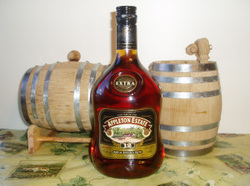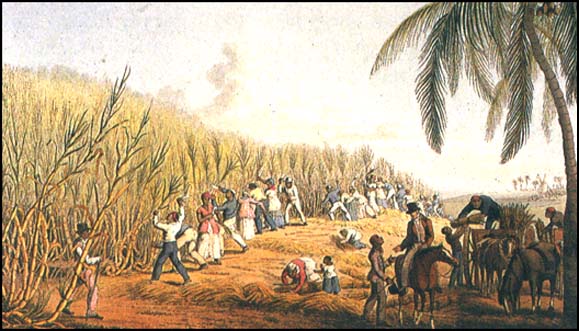The Industry of Sugar
Preface: Sugar was first used by humans as a natural and necessary constituent in our plant and meat foods. As farming evolved, humans identified and used various plants to produce sugar; such as sugar maple, sugar beet, sugar palm, sweet sorghum, and sweet corn. Sugarcane, however, is the most important source of sucrose in world history and, as will be alluded to further, in the Columbian Exchange. Sugarcane was originally developed and domesticated in New Guinea about 10,000 years ago. By A.D. 700 sugarcane had diffused to the Mediterranean region by Islamic expansion and trade. Sugarcane was viewed as an exotic spice and medicine, but by A.D. 1000, with the crusades and what not, it wriggled it's way into being an intrinsic part of a multitude of European dishes. By the 1500s, Spain and Portugal began sugarcane production in the milder Atlantic Islands. However, a much larger scale production of sugarcane shifts across the Atlantic to America with the introduction of sugarcane to Santo Domingo on Columbus' second voyage in 1493. Eventually, America surpassed Mediterranean sugarcane industry as huge plantations spread to Cuba, Puerto Rico, and Jamaica. In conjunction with industrialization in Europe the habit of sugar consumption with coffee, tea, and rum will become a drug-like addiction involving sugar, alcohol, and tobacco. Europeans, and eventually the world as it industrialized, would without perceiving the dangers of abuse, feed one of the largest cash crops and food businesses in the world.
The Cultivation of Sugarcane

Sugarcane
Sugar cane grows from a stem, into a tall upright plant that looks similar to reeds that grow on the banks of a river. Unlike most stems that are planted upright, a sugar cane stem has to be furrowed and placed on its side in order for it to grow. Sugar cane is a highly versatile plant that serves many functions. Europe could not cultivate sugarcane on their own lands because the conditions of the environment were not adequate. Therefore, they needed a location to cultivate the product to keep up with the demand caused by the everyday use of sugarcane. Since the Caribbean was a perfect environment for sugarcane cultivation, the Europeans saw a chance at turning a huge profit. At first the English would attempt to use native labor, but as the natives died off from disease or ran away to escape the encomienda, more labor was needed. Therefore, they turned to slave labor to be able to produce enough sugar for trade in the exchange. Slaves were brought over from West Africa and forced to work on the cultivation of sugar. Plantations were built all over the islands and the slaves would work the plantations under extreme conditions to keep up with the growing need for sugar. As sugar became more of a hot commodity around the world, more slave labor was needed to keep up with the demands. The cultivation of sugar cane was gruesome labor that would cost many African slaves their lives. However the Europeans needed cheap or free labor to continue on with the vast profit they were making, so more and more slaves were brought in to work. To the Europeans, it was cheaper to bring over more African slaves than it was to better the conditions and lessen the labor of their already existing slaves.
Sugarcane and Slavery

Slaves had a massive impact on the sugar industry
Initially, the labor for sugarcane plantations in America fell on the shoulders of Native Americans, but by 1600 95% of the American Indian populations in the Caribbean and Atlantic Coast populations were dead, mainly due to disease and labor. Since neither Indians nor Europeans adequately answered the labor needs of the plantations of the Americas, Africans became the glimmering solution. African slaves were brought across the Atlantic within a decade of Columbus’s voyages. First in small numbers, later in astounding ones, regular supplies of slaves were provided by traders who had bought them in Africa, where most originated as war captives from conflicts between Africans. Even under appalling conditions, though, African slaves fared far better than American Indian slaves had. The African slave populations had come from often tropical environments, similar in many ways to the Caribbean; they were accustomed to heat and humidity. If they survived infancy and childhood, they'd already, unlike Indians, developed resistance to the most deadly of Afro-European epidemics, including smallpox, and malaria, among many tropical diseases. In the end, costs favored the use of African slaves. The lower death rate of the Africans, plus their agricultural and technological skills weighed against the hostility of European free and indentured laborers who knew the master’s language, culture, and weaknesses, made African labor preferable. The reliance on slavery was so absolute that by the eighteenth century, Africans significantly outnumbered those of European descent in the entire Caribbean region by ratios as high as 13:1. Their darker skin colors also made them more easily identifiable as slaves, not free men; as “black” came to be synonymous with “slave,” racism was born. Out of the European justification of the enslavement and trade of Africans emerged an ideology of superiority based on skin color. This ideology came to assert the superiority of white Europeans and their cultural values over the rest of the world’s peoples.
Uses of Sugarcane

Sugarcane can be made into many useful things such as Molasses
With it's paramount industrialization throughout all corners of the world, sugar was used in a plethora of different ways. Here are just a few:
-Rum: When Barbados was settled in 1627, the British began to use the sugarcane they were growing there to start making rum. Up until that point, beer and brandy were considered the British drinks of choice, but when they began to distill rum from molasses, a byproduct of sugar production, it quickly swept the floor.
-Sugarcane Juice/Syrup: There were a large number of sugar refineries that were built in the new world expressly for the purpose of extracting sugarcane juice, which was mixed into a myriad of beverages. Since cane juice is easily digested, it provides the body with instant energy and hydration, which was extremely beneficial in the harsh summer climate of the region in which it was produced. This is probably the foremost reason as to why it was so popular with those who settled there.
-Molasses: Human cargo was sold for barrels of molasses, which was carried to refineries, and then made into rum. And some of that was then carried back to Africa. Molasses itself worked its way into the daily diet of all colonists. Northerners added molasses to baked beans, bean soups or corn chowder. Molasses was mixed with bourbon (or applesauce) and used as a marinade or glaze for poultry or pork, or mixed with tomato sauce, lemon juice and vinegar. Molasses also went into the baking of all manner of cookies, puddings, fruitcakes, and breads. Needless to say, it was a staple not only in the diet of these colonies, but in the entire industry that they fostered.
-Rum: When Barbados was settled in 1627, the British began to use the sugarcane they were growing there to start making rum. Up until that point, beer and brandy were considered the British drinks of choice, but when they began to distill rum from molasses, a byproduct of sugar production, it quickly swept the floor.
-Sugarcane Juice/Syrup: There were a large number of sugar refineries that were built in the new world expressly for the purpose of extracting sugarcane juice, which was mixed into a myriad of beverages. Since cane juice is easily digested, it provides the body with instant energy and hydration, which was extremely beneficial in the harsh summer climate of the region in which it was produced. This is probably the foremost reason as to why it was so popular with those who settled there.
-Molasses: Human cargo was sold for barrels of molasses, which was carried to refineries, and then made into rum. And some of that was then carried back to Africa. Molasses itself worked its way into the daily diet of all colonists. Northerners added molasses to baked beans, bean soups or corn chowder. Molasses was mixed with bourbon (or applesauce) and used as a marinade or glaze for poultry or pork, or mixed with tomato sauce, lemon juice and vinegar. Molasses also went into the baking of all manner of cookies, puddings, fruitcakes, and breads. Needless to say, it was a staple not only in the diet of these colonies, but in the entire industry that they fostered.

